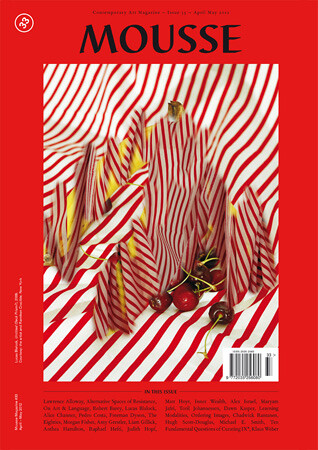April–May 2012
Morgan Fisher creates works that avoid subjectivity. Films that explore exhaustive combinations of possibilities, monochromes that elude compositional free will. The artist Christopher Williams met him to talk about his universe where everything makes perfect sense.
Andrea Lissoni met with the Portuguese director Pedro Costa, creator of fascinating, seductive and disturbing films, conveying a sense of monumental space through a gaze in which crudeness and sensuality coexist in eternal tension.
Taking his cue from the exhibition “This Will Have Been: Art, Love & Politics in the 1980′s,” curated by Helen Molesworth, Dieter Roelstraete reassesses the decade of individualism, bringing out its epochal breakthroughs, starting with activism based on sexual, post-colonial and racial identity.
The teaching of curating is a field of discussion still fraught with questions—a sea of potential but also of risky, uncharted courses. Jens Hoffmann and Johanna Burton moderate a conversation on curatorial studies, in an attempt to analyze the strengths and weaknesses of today’s educational programs.
On a number of occasions, Hans Ulrich Obrist has met with Freeman Dyson, one of the leading scientists of our time, discovering that his method is not so far from that of artists. Behind a great mathematician, in fact, lurks a refined connoisseur of literature and the arts.
The artistic method of Raphael Hefti consists in fully understanding the properties of a material in order to take it to extremes. Alexis Vaillant gets an introduction to the world of the artist’s projects, triggered by subjecting specific materials to the extreme effects of particular treatments.
The history of contemporary art is paved with collisions between art and language. Julian Myers gathers and interprets them, from Greenberg’s rejection of language to the reversal of modernist argumentation, all the way to the examination of the emblematic work of Art & Language and Dana DeGiulio.
Andrew Berardini supplies answers to the dilemma of the ongoing, unprecedented power of the historical works of Robert Barry—as well as the more recent ones—through the vastness of their intangible physical and mental boundaries.
The American Amy Gerstler is recognized as one of the outstanding poetic voices of the nation. The conversation with Catherine Taft intertwines the birth of her love for literature, poetry, and art with anecdotes and recollections of writers and artists, from Dennis Cooper to Mike Kelley.
In NICE TO MEET YOU: Jonathan Griffin analyzes the sculptures of Chadwick Rantanen, which appear as spatial fractures; Toril Johannessen explains to Adnan Yildiz how revolutions act on the notion of time; Hugh Scott-Douglas illustrates, for Ruba Katrib, how contingencies pervert his methods of duplication, producing unique things.
REPORTING FROM:
NEW YORK – Matt Hoyt creates compositions of sculptural objects based on careful research on synthetic materials that look natural, producing a sort of perceptive latency. The artist describes their properties for Cecilia Alemani.
LOS ANGELES – At the latest Whitney Biennial, Dawn Kasper has moved her studio into the museum. She tells Sarah Lehrer-Graiwer how performances, collages, drawings and sculptures, but above all encounters, stories and a challenge to demolish the past, all take place.
BERLIN – Klaus Weber and Judith Hopf have kept an eye on each other for a decade. Their affinities emerge from a semi-serious dialogue in which nature becomes a metaphor of escape, and animal emotivity a means of salvation.
LONDON – Alice Channer and Anthea Hamilton share a particular two-dimensional sensibility. The two artists discuss the reasons behind the impossibility of reasoning in three-dimensional terms, and the Duchampian concept of the “infra-thin.”
Luigi Fassi interviews Maryam Jafri to investigate her practice, a rewriting of historical narratives that connects events that happened in different places and times, openly toying with fictional and real events.
Ana Teixeira Pinto wonders what is money and what is its political value, through the works of artists who have focused on its equivocal material character and ontological ambiguity, from François Bucher to Anton Vidokle and Julieta Aranda.
For PORTFOLIO, Dominic Molon visits the work of Michael E. Smith with sharpened sensibilities, demonstrating that behind the radical transformation of refuse into sculpture, there is something more than a mere reflection on the American cult of consumption.
Alex Israel tells Gigiotto Del Vecchio that he has been inspired by many aspects of his hometown, Los Angeles, as emerges in the recent series of video-portraits “As It Lays,” from the sculptures made with film props, the painting-backdrops, and a particular extra-artistic accessory.
For years now Liam Gillick has been constructing spaces of discussion: structures that provide the body with a limited set of options, but also open up subversive, skeptical possibilities. Fionn Meade met with the artist to find out how they come about, and why his relationship with them is so problematic.
The recent revival of the English theorist Lawrence Alloway is interpreted by Ulrich Lehmann. Who was this thinker who invented an inclusive, open criticism, based on liberal positions? The author retraces Alloway’s career, revealing the lack of an ideological and political substrate.
Using analog photography and often employing postproduction methods like Photoshop, Lucas Blalock continues to rethink and question the photographic medium and its tools. Clara Meister met with the artist.
While in the sphere of mainstream culture what is marginal, to an increasing extent, seems to be absorbed by the center, in the world of art value grows with scarcity. Nato Thompson, for the fifth episode of What’s Alternative, edited by Vincenzo De Bellis, identifies islands of resistance to the powers that be.
TEN FUNDAMENTAL QUESTIONS OF CURATING is a project conducted by Jens Hoffmann and sponsored by Fiorucci Art Trust and Mousse Publishing, to explore the many faces of the curator. The ninth of ten dossiers presents Adriano Pedrosa who asks, “What is the process?”
Cover: Lucas Blalock, Untitled (Deck Prism?), 2009.
Courtesy the artist and Ramiken Crucible, New York.

